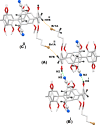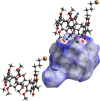Crystal structure and supra-molecular features of a host-guest inclusion complex based on A1/A2-hetero-difunctionalized pillar[5]arene
- PMID: 39372180
- PMCID: PMC11451480
- DOI: 10.1107/S2056989024009216
Crystal structure and supra-molecular features of a host-guest inclusion complex based on A1/A2-hetero-difunctionalized pillar[5]arene
Abstract
A host-guest supra-molecular inclusion complex was obtained from the co-crystallization of A1/A2-bromo-but-oxy-hy-droxy difunctionalized pillar[5]arene (PilButBrOH) with adipo-nitrile (ADN), C47H53.18Br0.82O10·C6H8N2. The adipo-nitrile guest is stabilized within the electron-rich cavity of the pillar[5]arene host via multiple C-H⋯O and C-H⋯π inter-actions. Both functional groups on the macrocyclic rim are engaged in supra-molecular inter-actions with an adjacent inclusion complex via hydrogen-bonding (O-H⋯N or C-H⋯Br) inter-actions, resulting in the formation of a supra-molecular dimer in the crystal structure.
Keywords: crystal structure; hetero difunctionalized pillar[5]arene; inclusion complex; supramolecular dimer.
© Vinodh and Al-Azemi 2024.
Figures




 − x, −
− x, − + y,
+ y,  − z; (iv)
− z; (iv)  − x,
− x,  + y,
+ y,  − z.
− z.
References
LinkOut - more resources
Full Text Sources
Miscellaneous
